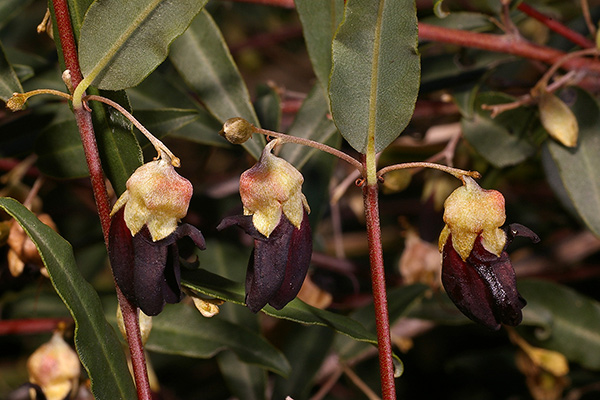
Everything New is Old Again
Jim Barrow
We have a lot of very pretty pea flowers. But many of them are difficult to put a name to. Well that has changed. Or has it?
One of the problems was that botanists used to put a lot of emphasis on the number of ovules in the ovary. This changed in 1987 when Crisp and Weston argued that it was not a reliable character. Its use, high in the classification, meant that similar plants were put into different boxes. Abandoning that idea meant that, for example Burtonia and Gompholobium were no longer regarded as separate. While none of us like having to learn new names it did make sense because the plants were similar. It also meant that Oxylobium almost disappeared because it had been largely differentiated using the same criterion.
 |
Gastrolobium stipulare was originally named in 1987 as Nemcia stipularis.
Photo: Garry Sankowsky. |
|
 |
Gastrolobium sericeum, formerly Brachysema sericeum, has a number of different colour forms.
Photo: Brian Walters. |
|
As part of these changes, they also split the peas (!) according to whether they were poisonous, that is contained sodium fluoroacetate or 1080. The poisonous ones were all to be called Gastrolobium, the non-poisonous Nemcia. Made a lot of sense from a practical point of view, though it was not an easy criterion to apply in order to identify a plant - unless you had a spare flock of sheep. There were also supposed to be differences in the way the inflorescence was arranged, but many of us found it difficult to see these.
This neat arrangement started to look a bit shaky when it was found that Nemcia spathulata did indeed contain 1080. The fit really hit the shan when studies were done using chemical markers. The argument here is that these studies show the true relationships and are not confused by superficial similarities caused by, for example, convergent evolution. (Yet most of us recognise the plants based on such similarities.)
|
|
|
Gastrolobium calycinum has always been classified under Gastrolobium.
Photo: Jim Barrow. |
|
When the results of these studies were fed into a computer program, Nemcias did not fall out as a neat and separate group. Some of them fell into the middle of Gastrolobium. The remainder fell to one end of the Gastrolobium "tree" but still well within the branch structure of Gastrolobium. Their very near neighbours, and also well within the Gastrolobium branches, were Brachysema and Jansonia. (Brachysema used to include the ribbon pea, but about half of the plants once called Brachysema have been changed to Leptosema. There is only one species of Jansonia) And the few remaining species of Oxylobium also fell into the middle of the tree.
The authors decided there was only one possible conclusion: they were all Gastrolobiums! As an overview, they suggest that there were two main evolutionary forces. One is defence against grazing. This led to high levels of 1080 and at one extreme, the development of lots of spines - well shown by G. spinosum, prickly poison (This led to an evolutionary escalation with animals developing increased resistance and plants presumably increased toxicity and spines.) The other is development of bird pollination which is best developed in the Brachysemas and Jansonia. The argument is that presence of 1080 is not compatible with bird pollination.
At least at the genus level, that makes it fairly easy. With 109 species there is a fair chance that anything you don't recognise as something else will be a Gastrolobium! Putting a species name to it is another matter. There is a key in the publication (Australian Systematic Botany 15,619- 739, 2002), but it is five and a half pages long so it can be a bit tedious.
Should we accept these changes? We don't have to, of course, but the Western Australian herbarium has adopted the changes for species within that state, which is the majority of species. On the other hand, Oxylobium is still accepted in New South Wales, although a number of former oxylobiums have been re-classified under Podolobium.
From the newsletter of the Wildflower Society of Western Australia, November 2003 - adapted with minor alterations approved by the author.
Australian Plants online - 2007
Association of Societies for Growing Australian Plants
|